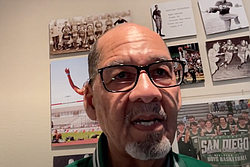Looking back at race relations in Coronado
A former football player recalls the good and the bad
Was Coronado San Diego’s most culturally diverse city, back in more racially divided days? The city’s historical society would like you to think so: it’s holding a groundbreaking exhibition entitled “An Island Looks Back,” and it suggests that said island was less egregious than many other San Diego communities. For starters, Coronado High School has always been integrated throughout its 135-year history. (As recently as 1977, 23 other schools in the county were segregated.)
Then there’s this surprising figure: the 1960 census showed that of Coronado’s 16,000 residents, 297 were African Americans. It doesn’t look like much, but that was double the black populations of Imperial Beach, Chula Vista, La Mesa, El Cajon, Escondido, Vista and Lemon Grove combined.
On the other hand, the school graduated only two African American students between 1921 and 1950. And most of those 297 residents arrived largely because of the Navy and a Federal housing project on the island, which lasted from 1944 till it was bulldozed in 1969.
At the exhibition, I run across Jim Love, who is 73, African American, and looking at his own picture, from the days when he was a Coronado High School football player. “This is where I grew up,” he says. “We came to Coronado from Forrest City, Arkansas in 1951. I was 11 years old. These pictures are of me and my older brother Charlie.” The two played football, “and Charlie was also on the 1956 basketball team. This would never have happened in the segregated schools of Arkansas. We had been sharecroppers. To us, Coronado was pretty luxurious. Here we had three bedrooms, an indoor toilet, and we got our first TV set!” He says life for a kid was idyllic. “There was always something to do. On the weekends, we got together with other kids in the projects, and some of the kids uptown, and we would play sports. White, black, didn’t matter. We were busy all the time. We were fishing, running around from the bay to the ocean. I was a lifeguard one summer at the Crown pool. I worked at two bowling alleys I cut lawns for people. I also worked at the car wash, and that’s how I learned to drive cars.”
Love says that “the racial thing was totally different compared with Arkansas. Back there, everything was segregated. They had the Colored Only fountain, the Colored Only doors, all of that. You couldn’t go into many stores, but if there was a store that served blacks and whites, you couldn’t try a hat on. Because if you tried it on, you had to buy it. But when we got here, we were all just kids. We didn’t even think about racism. And at the schools, especially once we became athletes at high school, we were more accepted by other people.”
Eventually, however, the City announced that they wanted that housing project land back. “Why? Because you can see what’s built there now, along the bay: The Marriott Hotel. That stretch is where our building was. Where we lived! We had a perfect view across the bay. But no blacks could purchase land. That lasted right from the 1930s to the 1980s, because of the covenants that were on the deeds” — and willingly enforced by local realtors. “So people like us lost out on having a transferable value to the land our house was on, because we [couldn’t] purchase any land. So when we had to leave the island, we had no wealth to transfer.”
And that’s the bittersweet flavor at this gathering. “In many ways,” says Jim Love, “life here was so much better. But there were ways in which it was just like everywhere.”
